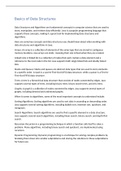Class notes
Material For Final Exam
- Course
- PROG 10082
This document describes the basics and detailed information for the Data Structures and Algorithms of Java. This Material was provided by the professor herself and said would be useful for the final exams and indeed it was useful. Consider taking a look to deep dive into the world of programming an...
[Show more]



